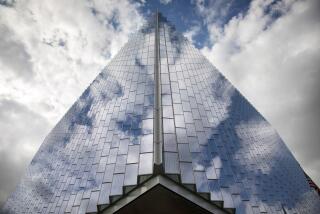After Five Years, Ride-Sharing Is Working, AQMD Says : Environment: But critics dispute the statistics. Some say the program’s anti-smog benefits do not live up to its costs.
Five years after regulators began the Gargantuan effort of prying Southern California’s solo drivers out of their cars and into van pools, buses and bicycles, the ride-share program is being hailed as a success by the agency that crafted and enforces it. But the findings are already being disputed.
Air quality has improved, car trips are down and the average number of passengers in each commuting vehicle has increased, says the South Coast Air Quality Management District in a staff report that will be released today.
“We’re somewhat pleased with the results so far,” said Bill Kelly, spokesman for the AQMD, which regulates 6,600 square miles of Los Angeles, Orange, San Bernardino and Riverside counties. “We really did not know how it would go. It does show that it’s working.”
The district’s program, known in air quality argot as Regulation XV, requires any employer with more than 100 employees at a single site to develop, submit and implement a ride-sharing plan. Most companies also need to reach a target of 1.5 riders per car driving to the work site between 6 and 10 a.m.
But though the new report says ride-sharing “is living up to its potential,” others in the pollution and transportation field contend that the benefits of the AQMD’s program--which affects fewer than 1.3 million of the area’s estimated 6 million workers--do not live up to the costs.
Some also question the district’s statistics, which show that the average number of passengers per vehicle commuting to work at the 5,000 affected companies is increasing. In contrast, a recent state Department of Transportation study shows a decreasing number of passengers per car commuting to work in Southern California.
Ride-sharing “only covers a small fraction of commuters,” said Joel Schwartz, staff scientist for the Coalition for Clean Air, an environmental group. “We also don’t know if those people are going home and driving their cars for errands after work. . . . The South Coast Air Basin still exceeds state ozone standards 150 days a year.”
When the program began in 1987, average vehicle ridership among covered employees was 1.13 passengers per vehicle. By September, 1992, the number of passengers had risen to 1.24 per vehicle.
What that means, the report said, is that ride-sharing has reduced the number of car trips in the district by 90,000 a day. In all, about 370,000 workers--30% of those covered by the plan--are regularly finding ways to get to work other than that lone drive with coffee mug and car radio.
In addition, the report says that ride-sharing has cut 90 tons of polluting emissions each day: 6.8 tons of hydrocarbons, 5 tons of nitrogen oxides and 78 tons of carbon monoxide. Hydrocarbons and nitrogen oxides are baked by sunlight to form ozone, which is a major component of smog and can cause breathing problems. Carbon monoxide can aggravate heart and lung diseases.
Leslie Jones, research manager at the Caltrans office of traffic improvement, said he has trouble with the AQMD figures because statistics by Caltrans and other agencies show that vehicle occupancy is down both statewide and in Southern California.
In the most recent Caltrans survey, which was not restricted to companies that have more that 100 workers per site, there were only 1.11 passengers per vehicle during Southern California work commutes. That’s down, he said, from 1.15 in 1976. The reason, he said, is that vehicle ownership is up.
“Vehicle occupancy is down,” Jones said. “This is confirmed by various other reports. . . . Everyone says there’s less people riding in a car. There may be more car pools out there, but there are fewer people.”
Another concern about the rosy ride-sharing picture painted by the AQMD is the basic focus of the district’s ride-sharing program, which targets the morning commute and does not curb solo trips to the mall, the movies and the doctor’s office.
“Regulation XV focuses on work trips, employee trips,” said James E. Moore, assistant professor of urban planning and civil engineering at USC. “That’s really not going to have a big impact on air quality. Three of four workday trips are not work trips. By focusing the attention of the 1,100 souls who work for AQMD on work travel, their attention is focused on the smallest part of the problem.”
The AQMD’s Kelly concedes that the district’s ride-sharing plan addresses a small percentage of auto use. But it’s a crucial chunk of the pollution picture. In addition, plans are in the works to expand the program later.
“The emissions that come from autos in the morning rush hour form the great bulk of that cloud of ozone (that travels from east to west through the basin),” Kelly said. “So the types of benefits you get from a program like this are greater than you would get by controlling pollution at other times.”
More to Read
Sign up for Essential California
The most important California stories and recommendations in your inbox every morning.
You may occasionally receive promotional content from the Los Angeles Times.











